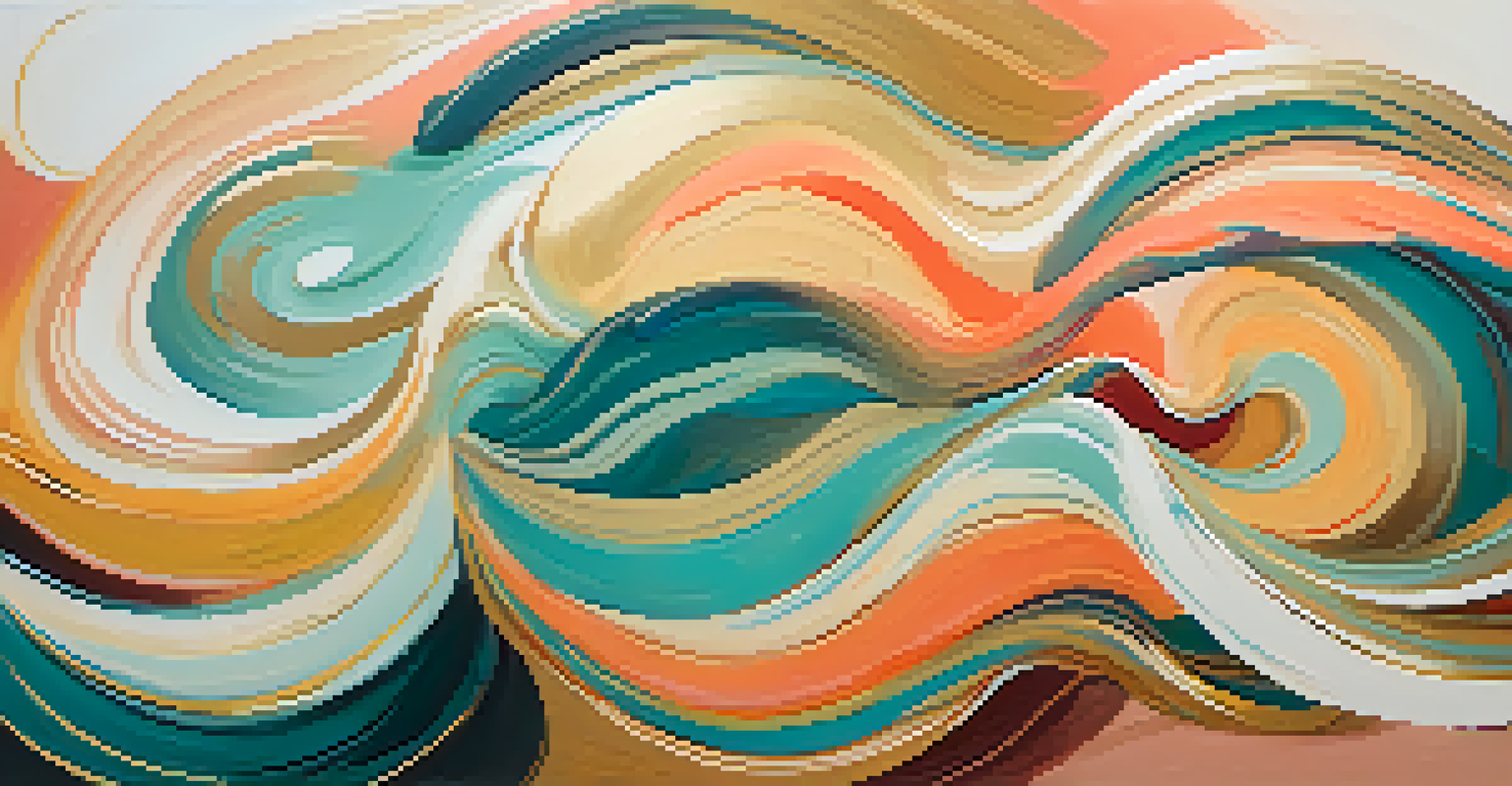The Aesthetic Experience: Philosophical Approaches to Art Critique

Understanding Aesthetics: What Is the Aesthetic Experience?
The aesthetic experience refers to the emotions and thoughts evoked when engaging with art. It encompasses our feelings of beauty, pleasure, or even discomfort, prompting us to reflect on our perceptions. This experience is subjective, meaning it can vary significantly from one individual to another, influenced by personal backgrounds and cultural contexts.
Art is not freedom from discipline, but disciplined freedom.
For example, a vibrant painting might elicit joy and energy in one person while causing another to feel overwhelmed or anxious. This underscores how art can speak differently to each of us, creating a unique dialogue between the viewer and the artwork. Understanding these varied responses is crucial for appreciating the depth of aesthetic experiences.
Philosophers have long debated the nature of these experiences, striving to define what makes something 'art' and how we should interpret its value. By exploring these discussions, we can gain insights into our own reactions and the broader significance of art in society.
Key Philosophical Theories Influencing Art Critique
Several philosophical theories shape how we critique art, each offering a distinct lens through which to view creativity. One prominent approach is formalism, which focuses on the elements of art such as color, form, and composition, rather than external contexts like the artist's biography or societal influences. This perspective invites viewers to appreciate the intrinsic qualities of the artwork itself.

Another important theory is expressivism, which emphasizes the emotional content of art. This approach suggests that the artist’s feelings and intentions play a significant role in understanding a piece. By prioritizing emotional expression, critics can delve into the narrative behind the artwork, fostering a more profound connection with the viewer.
Aesthetic Experience is Subjective
The aesthetic experience varies from person to person, influenced by individual backgrounds and cultural contexts.
Lastly, contextualism encourages us to consider the social, historical, and political contexts surrounding a piece of art. This theory highlights the significance of the environment in which art is created, pushing critics to explore how these factors shape meaning. Together, these theories provide a comprehensive framework for evaluating and appreciating art from multiple angles.
The Role of Subjectivity in Art Criticism
Subjectivity is a cornerstone in art criticism, reminding us that personal experiences and emotions significantly influence how we interpret art. What one person finds moving, another may view as uninspiring, illustrating the diverse reactions that art can provoke. This subjectivity challenges critics to acknowledge their biases and consider a broader spectrum of responses.
Every artist dips his brush in his own soul, and paints his own nature into his pictures.
For instance, a piece of art reflecting social justice may resonate deeply with someone who has experienced similar struggles, while others may not connect with it at all. Recognizing these varied perspectives enriches the critique process, as it allows for a more inclusive dialogue about art’s impact on different audiences. This conversation can lead to deeper insights and appreciation.
In embracing this subjectivity, critics can create space for diverse interpretations and foster a more vibrant artistic discourse. This ultimately enhances the aesthetic experience by inviting more voices into the conversation around art, making it a shared human experience.
Art and Emotion: How Feelings Shape Our Experience
The interplay between art and emotion is a fascinating area of study in aesthetics. Art has the unique ability to evoke strong feelings, whether it be joy, sorrow, nostalgia, or anger. These emotional responses can heighten our connection to a piece, making the experience more memorable and impactful.
For example, a haunting melody in a film can evoke tears, while a vibrant landscape painting may instill a sense of peace. These feelings can profoundly affect how we perceive the overall quality and significance of the art, demonstrating that our emotional reactions are integral to our aesthetic experience. It’s through these emotions that art often transcends mere visual pleasure.
Philosophical Theories Shape Critique
Key philosophical frameworks like formalism, expressivism, and contextualism provide diverse lenses for evaluating art.
Philosophers like David Hume have explored the relationship between emotion and aesthetics, suggesting that a well-crafted piece of art can resonate with our innermost feelings. This connection between art and emotion invites us to consider how our personal histories shape our reactions, enriching our understanding of both the artwork and ourselves.
Cultural Perspectives: Influences on Aesthetic Judgments
Cultural backgrounds play a significant role in shaping our aesthetic judgments, as what is considered beautiful or valuable can vary widely across societies. For instance, Western art often emphasizes individualism and expression, while many Eastern traditions focus on harmony and collective experience. These differing values can lead to contrasting interpretations and appreciations of the same artwork.
An example of this can be seen in the varying approaches to nature in art. In some cultures, nature is celebrated as a source of beauty and inspiration, while in others, it may be depicted as a powerful force to be respected and feared. Understanding these cultural contexts enhances our appreciation of art, revealing the diverse ways in which humans relate to their environment.
By acknowledging the influence of culture on our aesthetic judgments, we can cultivate a more nuanced understanding of art. This awareness can also foster empathy, enabling us to appreciate perspectives different from our own and enriching the global dialogue surrounding art.
The Impact of Technology on Aesthetic Experiences
In today's digital age, technology significantly influences our aesthetic experiences and the way we engage with art. From virtual galleries to social media platforms, technology has democratized access to artistic expression, allowing diverse voices to emerge. This shift not only changes how art is created but also how it is perceived and critiqued.
For example, the rise of digital art has challenged traditional definitions of art, prompting critics to adapt their frameworks to include new forms of creativity. This evolution raises questions about authenticity and value, as digital works can often be reproduced and shared widely. As a result, the conversation surrounding aesthetics is continually evolving, reflecting the changing landscape of artistic practice.
Technology Transforms Art Engagement
The digital age has democratized art access and interaction, reshaping how we create, perceive, and critique artistic expression.
Moreover, technology has enabled new forms of interaction with art, such as immersive experiences using virtual reality. These advancements invite viewers to engage with art in innovative ways, expanding the boundaries of what constitutes an aesthetic experience. As we navigate these changes, it’s essential to consider how technology shapes our understanding and appreciation of art.
Future Directions in Art Critique and Aesthetics
As we look to the future, the field of art critique and aesthetics is poised for exciting developments. Emerging trends suggest a growing emphasis on inclusivity and diversity, encouraging critics to explore underrepresented voices and perspectives in the art world. This shift can lead to a richer, more nuanced understanding of art and its impact on society.
Additionally, interdisciplinary approaches are gaining traction, merging insights from fields like psychology, sociology, and neuroscience with traditional art critique. This integration can provide deeper insights into the human experience of art, revealing new ways to understand our reactions and interpretations. As we continue to explore these intersections, the conversation around art will undoubtedly become more vibrant and multifaceted.

Ultimately, the evolution of art critique and aesthetics reflects the dynamic nature of art itself. By embracing change and fostering open dialogue, we can continue to deepen our understanding of art’s role in our lives and its power to inspire, provoke, and connect us all.